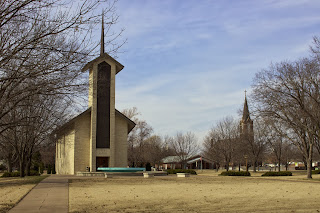Abilene Kansas is located in the center of the state.
Rolling hills and plains surrounds it. I am disappointed in movie and
television depictions of Clark Kent’s childhood capturing a flat and
featureless American landscape of farms, when Kansas is the opposite. It’s the
land of cowboy’s and beautiful pastures where cattle graze. Abilene is the
pleasant small town America one can discover in each state.
Ike was not born here, but raised here after the family
moved from Texas. He was the middle child in a set of siblings successful in
each respective field. Two quotes that stand out from the trip were one from
Dwight’s mother when asked if she was proud of her son, she replied, “Yes, of
course, which one?” The other from his mother, that anyone seeking an education
could find it.
This is what Ike did when joining West Point. Getting an
education when he could not pay for school. Ike did well in the things he was
interested in and poorly in those he didn’t. Classmates included famous
military leaders from WWII including George Patton.
Ike’s time in service missed WWI, or the Great War, and put
him in charge of the Allied Command of WWII. After the war he was President at
Columbia University, an author, ran NATO, and became the candidate for the
Republican ticket for US President.
In Abilene you will find a pleasant campus to hold the gift
store, where tickets are purchased, the library, where his documents and papers
are housed, museum, and a place for meditation, in which he, his wife, and
child who died early in life are buried. All of these building surround the childhood
home he was raised in, and mother lived through the end of her days.
Parts of the museum have been updated recently; I would look
forward to a return when more has been revisited. In many presidential museums
we learn about the impacting people and influential circumstances that helped
to shape them. It helps us to understand why they made the choices they did.
And while there is a small part about the man, his life, and loves, this story
is primarily a history of WWII. It is the build up, the causes, the players,
and the execution of war. There are lots of guns, artillery, and mortars along
with the vehicles that supported and moved them.
“Stories I Tell My Friends” was the inspiration to visit all
of the Presidential Museums. After reading this book by Ike, I wanted to learn
more about what made these men of leadership choose the actions they took.
While a great book, and the museum showed many of these accomplishments and
drivers, I was disappointed that it was focused so much on WWII. That is, until
I went to Kansas City the following day to see the WWI museum. The combination
of these two locations together give a much better appreciation of the lead up
to the second world war, and how the clear goals and plans Ike made helped to
end this long running struggle.
For me there were a few decisions that Ike made that were
unclear until I visited. The first was
the landing area for D-Day, which later became an engineering marvel of
Mulberry Bay. If you don’t know much about this topic, I highly recommend
looking into it. This may be one of the
key plans that helped to win the war. Second, why not aid the Hungarian
revolution in 1958? In an interview after office on a movie reel, it was clear,
no neighboring country would allow the US to move over their territory. So he
focused on a crisis in Egypt that month instead.
I like Ike. I like Ike a good deal. There is something about
him that comes across as being an honest and intelligent man. Many of the
positions he held were not ones he sought out, but instead asked him to serve.
Like Hoover, there is a solid pattern of people seeking advice and guidance
from him years later, Kennedy, LBJ, Nixon.















No comments:
Post a Comment